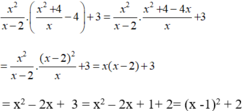Hãy nhập câu hỏi của bạn vào đây, nếu là tài khoản VIP, bạn sẽ được ưu tiên trả lời.

Điều kiện x ≠ 2 và x ≠ 0

Vì x - 1 2 ≥ 0 nên x - 1 2 + 2 ≥ 2 với mọi giá trị của x.
Khi đó giá trị nhỏ nhất của biểu thức bằng 2 khi x = 1.
Vậy biểu thức đã cho có giá trị nhỏ nhất bằng 2 tại x = 1.

Dài quá trôi hết đề khỏi màn hình: nhìn thấy câu nào giải cấu ấy
Bài 4:
\(A=\frac{\left(x-1\right)+\left(x+1\right)}{\left(x+1\right)\left(x-1\right)}-\frac{2}{\left(x+1\right)\left(x-1\right)}=\frac{2\left(x-1\right)}{\left(x-1\right)\left(x+1\right)}\)
a) DK x khác +-1
b) \(dk\left(a\right)\Rightarrow A=\frac{2}{\left(x+1\right)}\)
c) x+1 phải thuộc Ước của 2=> x=(-3,-2,0))
1. a) Biểu thức a có nghĩa \(\Leftrightarrow\hept{\begin{cases}x+2\ne0\\x^2-4\ne0\end{cases}}\)
\(\Leftrightarrow\hept{\begin{cases}x+2\ne0\\x-2\ne0\\x+2\ne0\end{cases}}\)
\(\Leftrightarrow\hept{\begin{cases}x\ne-2\\x\ne2\end{cases}}\)
Vậy vs \(x\ne2,x\ne-2\) thì bt a có nghĩa
b) \(A=\frac{x}{x+2}+\frac{4-2x}{\left(x-2\right)\left(x+2\right)}\)
\(=\frac{x\left(x-2\right)}{\left(x+2\right)\left(x-2\right)}+\frac{4-2x}{\left(x+2\right)\left(x-2\right)}\)
\(=\frac{x^2-2x+4-2x}{\left(x+2\right)\left(x-2\right)}\)
\(=\frac{x^2-4x+4}{\left(x+2\right)\left(x-2\right)}\)
\(=\frac{\left(x-2\right)^2}{\left(x+2\right)\left(x-2\right)}\)
\(=\frac{x-2}{x+2}\)
c) \(A=0\Leftrightarrow\frac{x-2}{x+2}=0\)
\(\Leftrightarrow x-2=\left(x+2\right).0\)
\(\Leftrightarrow x-2=0\)
\(\Leftrightarrow x=2\)(ko thỏa mãn điều kiện )
=> ko có gía trị nào của x để A=0


Vì \(x^2-4x+5=x^2-4x+4+1=\left(x-2\right)^2+1\ge1>0\) với mọi giá trị của \(x\) nên giá trị của biểu thức luôn luôn âm với mọi giá trị khác 0 và khác -3 của \(x\)

Bài 1:
a) x≠2x≠2
Bài 2:
a) x≠0;x≠5x≠0;x≠5
b) x2−10x+25x2−5x=(x−5)2x(x−5)=x−5xx2−10x+25x2−5x=(x−5)2x(x−5)=x−5x
c) Để phân thức có giá trị nguyên thì x−5xx−5x phải có giá trị nguyên.
=> x=−5x=−5
Bài 3:
a) (x+12x−2+3x2−1−x+32x+2)⋅(4x2−45)(x+12x−2+3x2−1−x+32x+2)⋅(4x2−45)
=(x+12(x−1)+3(x−1)(x+1)−x+32(x+1))⋅2(2x2−2)5=(x+12(x−1)+3(x−1)(x+1)−x+32(x+1))⋅2(2x2−2)5
=(x+1)2+6−(x−1)(x+3)2(x−1)(x+1)⋅2⋅2(x2−1)5=(x+1)2+6−(x−1)(x+3)2(x−1)(x+1)⋅2⋅2(x2−1)5
=(x+1)2+6−(x2+3x−x−3)(x−1)(x+1)⋅2(x−1)(x+1)5=(x+1)2+6−(x2+3x−x−3)(x−1)(x+1)⋅2(x−1)(x+1)5
=[(x+1)2+6−(x2+2x−3)]⋅25=[(x+1)2+6−(x2+2x−3)]⋅25
=[(x+1)2+6−x2−2x+3]⋅25=[(x+1)2+6−x2−2x+3]⋅25
=[(x+1)2+9−x2−2x]⋅25=[(x+1)2+9−x2−2x]⋅25
=2(x+1)25+185−25x2−45x=2(x+1)25+185−25x2−45x
=2(x2+2x+1)5+185−25x2−45x=2(x2+2x+1)5+185−25x2−45x
=2x2+4x+25+185−25x2−45x=2x2+4x+25+185−25x2−45x
=2x2+4x+2+185−25x2−45x=2x2+4x+2+185−25x2−45x
=2x2+4x+205−25x2−45x=2x2+4x+205−25x2−45x
c) tự làm, đkxđ: x≠1;x≠−1

a, Ta có : \(\dfrac{98x^2-2}{x-2}=0\Leftrightarrow\left\{{}\begin{matrix}98x^2-2=0\\x-2\ne0\end{matrix}\right.\)
hay \(\left\{{}\begin{matrix}x^2=\dfrac{1}{49}\\x\ne2\end{matrix}\right.\Leftrightarrow x=\pm\dfrac{1}{7}\)
Vậy giá trị của phân thức này bằng 0 khi \(x=\pm\dfrac{1}{7}\)
b, Ta có : \(\dfrac{3x-2}{x^2+2x+1}=0\Leftrightarrow\dfrac{3x-2}{\left(x+1\right)^2}=0\Leftrightarrow\left\{{}\begin{matrix}3x-2=0\\\left(x+1\right)^2\ne0\end{matrix}\right.\)
hay \(\left\{{}\begin{matrix}x=\dfrac{2}{3}\\x\ne-1\end{matrix}\right.\)
Vậy giá trị của phân thức này bằng 0 khi \(x=\dfrac{2}{3}\)
a)
98x^2 -2 =0 =>x^2 =1/49 => x= -+1/7 nhận
b)
3x-2=0=>x=2/3 nhận

Điều kiện x ≠ -2 và x ≠ 0
Vì x + 1 2 ≥ 0 nên - x + 1 2 ≤ 0 ⇒ - x + 1 2 - 1 ≤ - 1
Khi đó biểu thức có giá trị lớn nhất bằng -1 khi x = -1
Vậy biểu thức đã cho có giá trị lớn nhất bằng -1 tại x = -1.